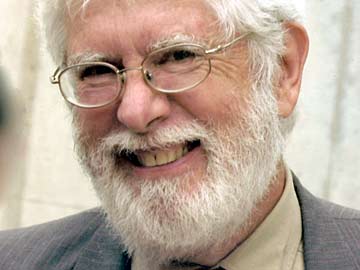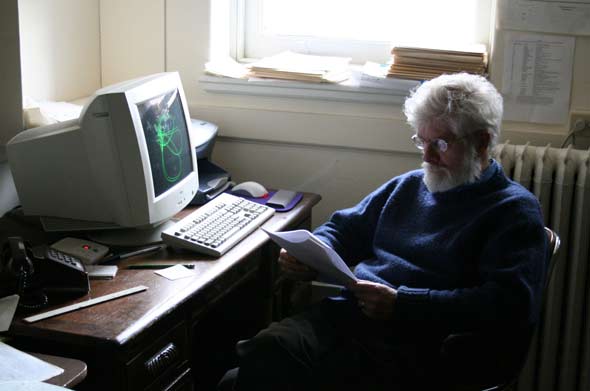

![]()
![]()
![]()
![]()
|
The news that Maya research lost one of its great characters and talents, Christopher Jones, on September 4, 2015, deeply saddens all who were lucky enough to know him and the greater number who admired his work. In a career that spanned six decades, Chris proved himself to be both a skilled excavator and an innovative epigrapher whose contributions will be felt for a long time to come.
The son of William Powell Jones and Marian Ginn Jones, Chris was born in Gates Mills, Ohio, in 1937. He first went to Harvard for a bachelor degree in English, before coming to the University of Pennsylvania in 1959 to study anthropology, completing his M.A. in 1963 and Ph.D. in 1969. It was at Penn that he encountered his two great academic mentors, Linton Satterthwaite and William Coe, with Linton giving Chris his entrée into the world of Maya hieroglyphs and Bill an advanced education in Maya fieldwork. |
| This was an exciting time to be studying the Maya at Penn, since it was in the midst of the University Museum's major program of excavations at Tikal, Guatemala—a project that ran from 1956 until 1970. Chris already had field experience in the Dordogne region of France, but shifted to Tikal in 1962. He began by excavating the Twin-Pyramid Groups dotted across the site, complexes dedicated to celebrating the twenty-year K'atun period that was so central to royal performance in the Classic era. He succeeded in identifying some additional examples, one of them buried beneath later structures in the East Plaza. He turned that research into his dissertation, but went on working in the East Plaza to conduct a much wider areal analysis. There he recognized a group of concentric buildings lacking residential characteristics as the core of a marketplace, a commercial space that extended out to the open colonnades that fringed the entire plaza. |

Chris at Tikal, 1964. Photo: Virginia Greene. |
|
That project was ultimately published in 1996 as Excavations in the East Plaza of Tikal (Jones 1996), and provoked his keen interest in trade and transportation. This was reflected in the book chapter "El comercio y las rutas de intercambio de los mayas" (1999) and, in his most recent publication, the chapter "The Marketplace at Tikal" (2015).
In 1966 Chris had taken a teaching post in anthropology at the University of Buffalo, New York, and it was during his time on the shores of Lake Erie that he met art teacher Leslie Wright, whom he married in 1968. The University Museum brought him and his new family back to Philadelphia in 1973, where he took up Satterthwaite's old office and devoted himself to research and publication. But he was not done with archaeology and in 1976 became a key contributor to Penn's new field project at Quirigua, Guatemala. Leslie and the family joined him there, setting up a temporary home in the nearby town and joining the life of excavators in the field. By day Chris concentrated on the main acropolis at the site, digging down through the surface remains to reveal the layout of its earlier phases. His most impressive find was a wall embellished with mosaic masks of the Sun God, faces that would once have looked out onto the old course of the Motagua River. Those excavations will be published by the Museum as the monograph Archaeological Investigations in the Site Core, Quirigua, Izabal, Guatemala, co-authored with his close colleague and project director Robert Sharer. Chris greatly admired the contributions of Tatiana Proskouriakoff, the epigrapher whose reading of the inscriptions at Piedras Negras first unravelled Classic Maya history, published in American Antiquity in 1960. There was a strong Penn connection here since she once worked in the same offices and Chris would sometimes draw while perched on her old drafting stool. He was to follow in her footsteps with a breakthrough she would have been proud of, deciphering the statements for "child of mother" and "child of father." At a stroke this revealed the genealogical relationships between the kings not only at Tikal but across the Maya world. This was part of his efforts to understand the city's dynastic sequence, published in 1977 as the "Inauguration Dates of Three Late Classic Rulers of Tikal, Guatemala," also for American Antiquity (Jones 1977). His hieroglyphic opus The Monuments and Inscriptions of Tikal: The Carved Monuments—a collaboration with Satterthwaite—was published by the University Museum (Jones and Satterthwaite 1982). It remains the standard work on the chronology and history of Tikal, richly illustrated with the expert renderings of Bill Coe. Chris and Leslie had settled in rural Pennsylvania at Kimberton, where they bought an old farmhouse to raise their growing family and kept a collection of chickens and goats. Milking the nannies was a regular and much enjoyed part of Chris's day, and the yield was imbibed as it was or converted into his own goat's cheese. He was active in the local history society at Kimberton and, ever the natural storyteller, enjoyed giving public lectures on a range of topics. This passion for education found another outlet when together with Elin Danien he founded the Maya Weekend at the University Museum (now Penn Museum). This drew an interested public numbering in the hundreds to talks by leading scholars, accompanied by workshops on the hieroglyphs that he regularly lead. Chris had a special quality of cheery enthusiasm and touched everyone with his warmth, kindness, and generosity. He was a tactile person—greeting you not only with a beam of a smile but often a firm shake of your shoulder or a one-armed hug as well. In his work he was a perfectionist in the best sense of the word and his writing had great clarity and precision. He argued passionately for his ideas, yet never took offence in the cut-and-thrust of debate and was always keen to hear the opinions of others. Stalwart colleagues are often admired, but few provoke as much personal affection as he did. Chris is an irreplaceable presence within Penn Museum and the field of Maya studies as a whole and, speaking personally, I will miss him a great deal. He is survived by his wife Leslie, sons Edward, William, Frederick, and Ashton, and grandchildren Moses, Carson, Gabriel, Zachary, Samson, Sebastian, and Quinn. |
